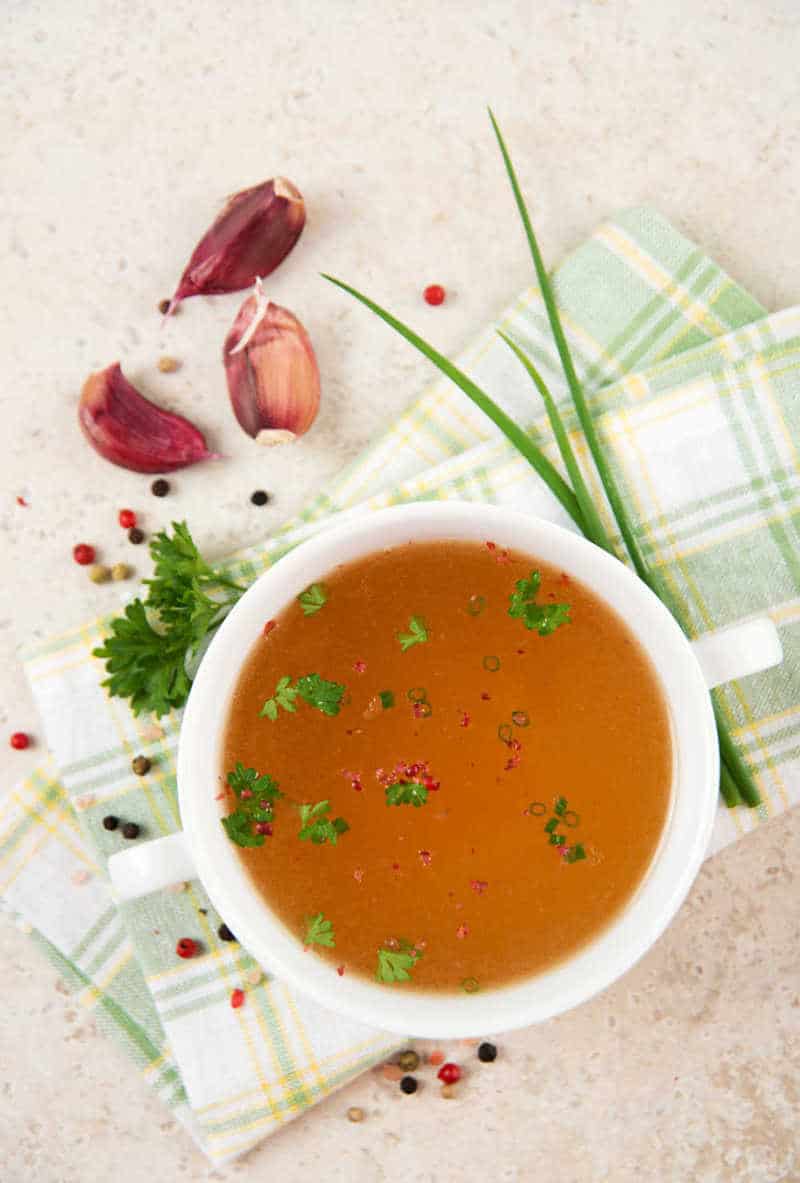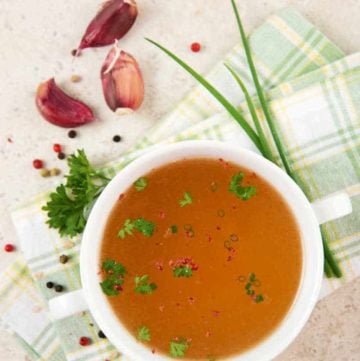Whether you’re making homemade chicken noodle soup or a hearty skillet meal, understanding the differences between chicken stock, bouillon, and chicken base will transform your cooking. These three pantry staples each serve unique purposes, and knowing when to use which one can elevate your dishes from good to restaurant-quality.
Quick Reference: Stock = liquid foundation | Bouillon = dehydrated cubes | Base = concentrated paste

This post contains affiliate links. As an Amazon Associate, I earn from qualifying purchases.
This post contains affiliate links. As an Amazon Associate, I earn from qualifying purchases.
Table of Contents
What is Chicken Stock?
Chicken stock is a clear, flavorful liquid made by simmering whole chickens or chicken bones with vegetables and seasonings for several hours. Think of it as the liquid foundation for countless recipes.
Key Characteristics:
- Appearance: Light golden color with thin consistency
- Flavor: Mild, clean chicken taste
- Texture: Liquid that may gel slightly when chilled
- Best for: Soups, risottos, cooking grains, and recipes requiring large amounts of liquid
Basic Ingredients:
- Whole chickens or chicken bones – Provide the essential chicken flavor and gelatin
- Aromatic vegetables – Carrots, onions, and celery (called mirepoix) add depth
- Fresh seasonings – Kosher salt, black pepper, garlic, herbs like thyme or parsley
- Water – The liquid base that extracts flavors during long, slow cooking
How to Make Chicken Stock at Home:
- Combine ingredients in a large stockpot: chicken pieces, chopped vegetables, and seasonings
- Add cold water to cover chicken completely by 2 inches
- Bring to a gentle simmer (never boil, which creates cloudy stock)
- Simmer uncovered for 3-4 hours, skimming foam occasionally
- Strain through fine mesh and cool quickly for storage
Pro Tip: Homemade stock costs significantly less than store-bought and delivers superior flavor depth.
What is Chicken Bouillon?
Bouillon is simply dehydrated stock that’s been compressed into convenient cubes or granules. It’s the quickest option when you need chicken flavor fast.
Key Characteristics:
- Appearance: Small cubes or granulated powder
- Flavor: Concentrated and often quite salty
- Convenience: Dissolves instantly in hot water
- Best for: Quick soups, seasoning vegetables, emergency flavor boost
How to Use Bouillon:
- Standard ratio: 1 cube or 1 teaspoon granules per 1 cup boiling water
- Dissolve completely before adding other ingredients
- Taste first before adding additional salt, as bouillon is often very salty
- Choose low-sodium versions if controlling salt intake
Important Note: While convenient, bouillon often contains preservatives and can taste artificial compared to homemade alternatives.
What is Chicken Base?
Chicken base is the powerhouse of the trio. It’s essentially ultra-concentrated stock that’s been reduced to a thick, paste-like consistency through hours of additional cooking.
Key Characteristics:
- Appearance: Thick, dark paste or concentrated powder
- Flavor: Rich, intense, and complex
- Color: Much darker than regular stock, similar to beef broth
- Best for: Sauces, gravies, stews, and dishes needing robust flavor
Popular Brands:
- Better Than Bouillon – Most widely available concentrated base
- Minor’s – Professional kitchen favorite
- Homemade versions – Most flavorful and cost-effective option
How to Make Chicken Base at Home:
- Start with stock ingredients: Whole chicken, mirepoix vegetables, garlic, herbs, salt, pepper, and water
- Simmer for extended time: Cook for 6-8 hours until liquid reduces by 75%
- Strain and reduce further: Continue cooking strained liquid until thick and paste-like
- Cool and store: Refrigerate up to 1 week or freeze in portions for months
Storage Tip: Freeze homemade base in ice cube trays for convenient single-serving portions.
When to Use Each Option
Choose Chicken Stock For:
- Soup bases requiring large liquid volumes
- Cooking grains like rice, quinoa, or barley
- Braising liquids for gentle, moist cooking
- Light sauces where subtle flavor is preferred
Choose Bouillon For:
- Quick weeknight cooking when time is limited
- Seasoning vegetables during sautéing
- Emergency situations when no other options are available
- Camping or travel cooking due to portability
Choose Chicken Base For:
- Rich gravies and sauces needing intense flavor
- Hearty stews and braises where depth matters
- Skillet meals requiring concentrated taste
- Professional-quality results in home cooking
Why Chicken Base Often Works Best
Flavor Concentration: The extended cooking time allows flavors to meld and intensify far beyond regular stock levels.
Versatility: Because it’s concentrated, you control the strength by adjusting the amount used.
Consistency: The thicker texture helps sauces and gravies achieve proper body without additional thickeners.
Storage Efficiency: Takes up minimal refrigerator or freezer space compared to liquid stock.
Cost Effectiveness: One batch provides equivalent flavor to multiple batches of regular stock.
Recipe Applications and Substitutions
Perfect Uses for Homemade Chicken Base:
- Rich Chicken Gravy – Creates restaurant-quality depth
- Chicken and Dumplings – Provides robust broth foundation
- Cheeseburger Soup – Adds meaty, savory background
- Baked Potato Soup – Enhances creamy, comforting flavors
- Vegetable Beef Stew – Intensifies overall savory profile
- Chicken Casseroles – Delivers concentrated flavor throughout
Substitution Guidelines:
- Replace stock: Use 1 teaspoon base per 1 cup water
- Replace bouillon: Use half the amount of base for equivalent saltiness
- Enhance store-bought: Add 1/2 teaspoon base to canned stock for improved flavor
Expert Tips for Best Results
Quality Ingredients: Use the freshest chicken and vegetables possible for superior flavor development.
Temperature Control: Maintain gentle simmer throughout cooking to prevent cloudy or bitter results.
Skimming Technique: Remove foam and impurities regularly for cleaner final product.
Proper Storage: Cool quickly and store safely to maintain quality and prevent spoilage.
Taste Testing: Always taste before adding additional salt, especially when using concentrated bases.
The Bottom Line
While all three options have their place in the kitchen, homemade chicken base offers the best balance of flavor, versatility, and value. Stock provides the foundation for many dishes, bouillon offers convenience, but base delivers the concentrated flavor that transforms ordinary recipes into extraordinary meals.
Pro Cook Secret: Many professional kitchens rely primarily on bases for their intensity and consistency. Making your own puts restaurant-quality flavor at your fingertips while saving money and controlling ingredients.
Whether you choose the convenience of bouillon, the classic appeal of stock, or the concentrated power of base, understanding these differences will elevate your cooking and help you choose the right option for every recipe.
A Few Ways to Use Your Homemade Chicken Base
(Note: If the copycat recipe calls for chicken stock or bouillon, swapping it out for chicken base will yield a tastier dish. I’ve been switching to a chicken base more and more.)
- Chicken Gravy – Learn how to make it.
- Chicken and Dumplings
- Meaty soups like Cheeseburger soup
- Vegetable soups like Baked Potato Soup
- Hearty Stews such as Vegetable Beef Stew
- Chicken Casseroles
Homemade Chicken Base
Ingredients
- 2 pounds chicken bones you can use backs, wings, and other leftover trimmings
- 1 onion quartered
- 2 celery stalks
- 2 carrots peeled, and quartered
- 1 bunch parsley if desired
Instructions
- Place the chicken into a large stockpot. Place the vegetables on top of the chicken.
- Cover with water.
- Gently heat the stock, do not allow the stock to boil.
- Cook for about 3 hours on low.
- Strain the stock, and return the liquid to the pot. Reduce the liquid in half.
- Use the remaining liquid as base.
Notes
- parsnips
- a clove of garlic
- shallots




I truly appreciate this recipe. I have been trying so hard to find a Chicken Base I can use for soups that do not contain MSG or high levels of sodium. This is absolutely wonderful. I appreciate being able to control what goes into my food more.
I’ve enjoyed many of your recipes. Thank you. However your pages are difficult to read because they include too many misplaced icons for me to click on whatever, things I don’t use; like pinterest, facebook, etc., that appear on the left-most side of the screen and block out text as I’m scrolling vertically to read your text. Those same ‘icons’ appear also at the bottom of the page. Really annoying and difficult to ignore. I wish I could include a screen shot of this page so you could see what I’m trying to explain.
I appreciate your comments, I know the site will be undergoing a revision in June, I will address your comments then.
I’m on the site now and I agree it’s hard to read w the icons that still remain
I am terribly sorry you do not like the extra icons. I will keep this in mind for the future.
I had always thought that chicken bouillon cubes were simply dehydrated chicken stock that had been shaped into cubes, as you describe here. However, recently I noticed that all three brands of chicken bouillon cubes that we happen to have in the house are actually labelled “Chicken Flavor Bouillon.” I was pretty dismayed, thinking that perhaps the flavor in them isn’t actually from chicken after all. I decided to research it a bit, and that’s how I came across your article/ post. So now I”m wondering, what are your sources for the information in the article? I’m just curious, because you don’t specifically say. Is it based on your background and/ or cooking training, or is it based on an online or print source that I might be able to also read?
Sure, so this knowledge was my own. I have 30+ years of cooking experience, and 25+ years of recipe development. I have also written two cookbooks, co-authored an ebook. I have had culinary training at a culinary school as well.
Thank you for the information of the difference between the three. You made mention of helping us in the kitchen with almost everything but I was wondering if you could also come help with doing the dishes? Lol. ?
I am with you on this! I hate doing dishes!
This was so helpful. Thank you!
I have a question, I have tried, unsuccessfully, to make chicken stock with just boiling the bones. I shred and freeze th3 chicken for other recipes. My question is when maki,g your own chicken base, is the chicken still good to use and freeze and do you continue to boil bone and vegetables to make the stock or base ??
First, the chicken is fine for another use. Next, continuing to boil the bones isn’t going to make it any better. I will save my stock from cooking and wind up adding a soup base to it because it requires much more flavor. They just don’t grow chickens the way they used to; they are feed differently; therefore lighter meat and less flavor. #redibasecooking
So I am late to answer this, but when I make stock at home. I use the bones, skin, and I prefer wings, or necks to make stock with. I place in a large pot all of my chicken pieces, some veggies like carrots, celery, and onion. I add enough water to cover the chicken completely. Then a simmer this for a few hours. I never try to boil this mixture.
If you want to condense this, you would remove all of the solids, and then boil out some of the water. You can reduce this “stock” by half, and then you will have a very flavorful stock.
Some people consider chicken base as a chicken stock that has been reduced over a couple of hours until the vegetables in the stock completely melt into the liquid.
Would you mind if I used your chicken stock image and linked back to this page as part of a post I’m doing on crock pots? Thanks! Alicia Kazsuk, VibrantHomeschooling.com
You can use it if I get credit.
Wouldn’t linking back to your page by its very definition be giving you credit?
I believe so.
This recipe is filed in
Soup Recipes
Differences between chicken stock, chicken bouillon, and chicken soup base
I click on print recipe and there is none.
I totally agree. Very very useful information. I always wondered about the differences between the 3, but unfortunately it was not so easy to find, anywhere on the internet, a straightforward explanation as is given here. I was very happy to see this.
Thanks to Stephanie for creating this beautiful site and an great idea of 一in her own words一 helping readers to recreate their favourite restaurant recipes, so that they can prepare these dishes at home!!
Good luck to you always, Stephanie! ????
Thank you very much 😉
There is no recipe here, this was only an explanation.
Thank you!! This info was super helpful and clearly explained the differences.